
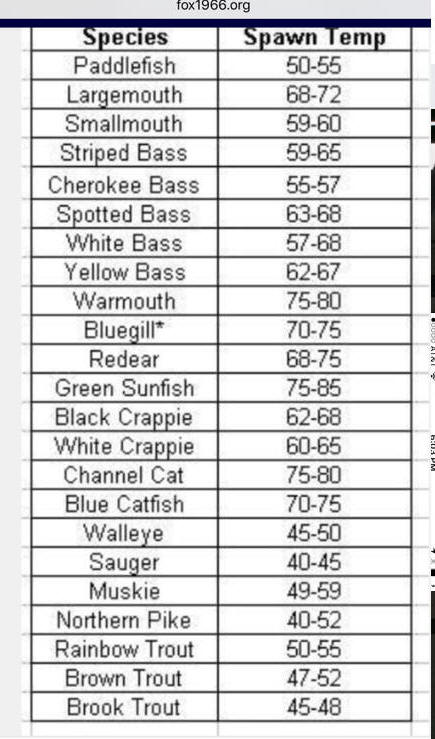
Bass Spawning
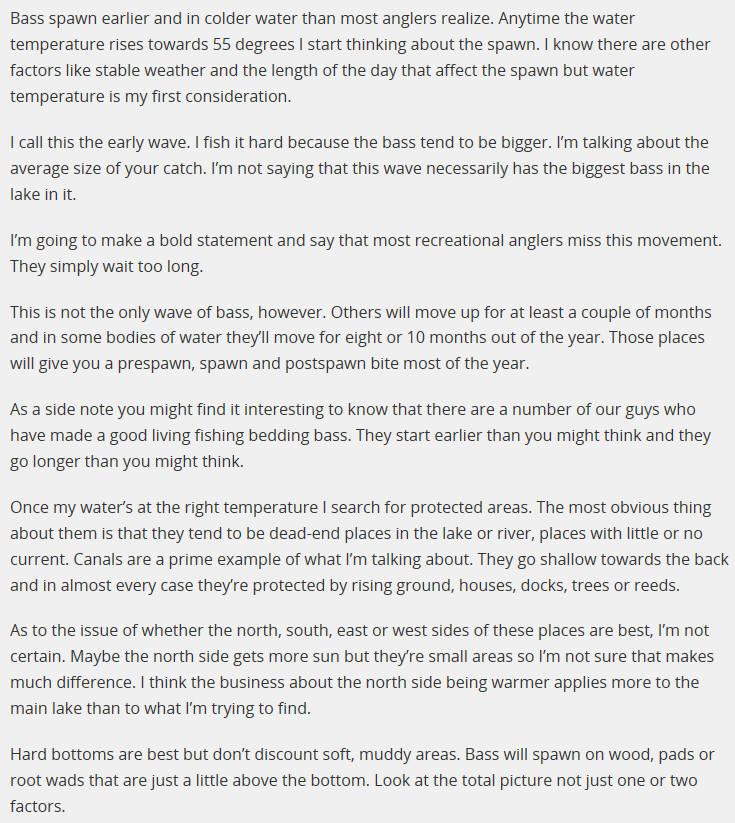
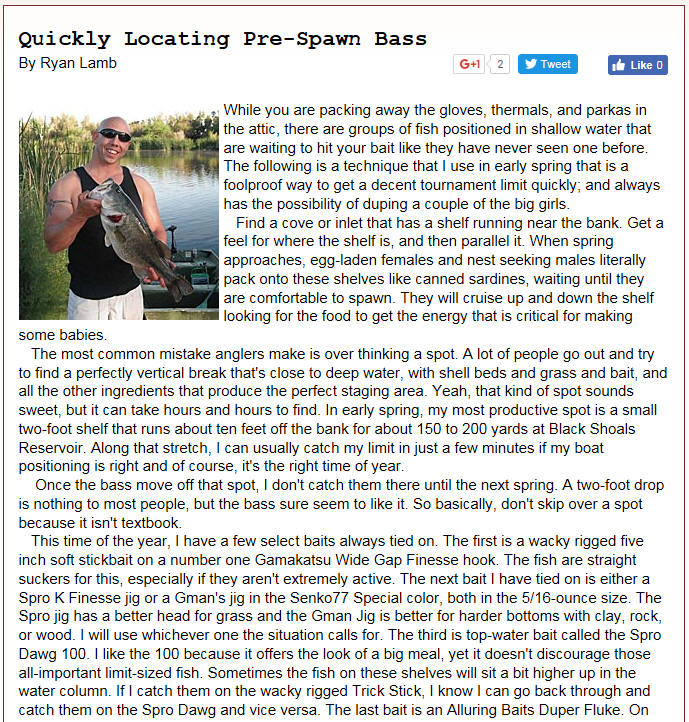
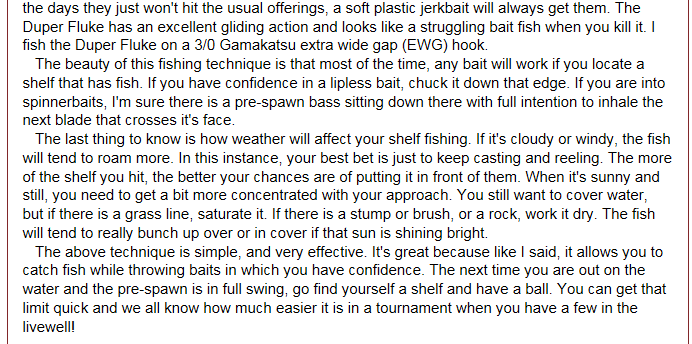
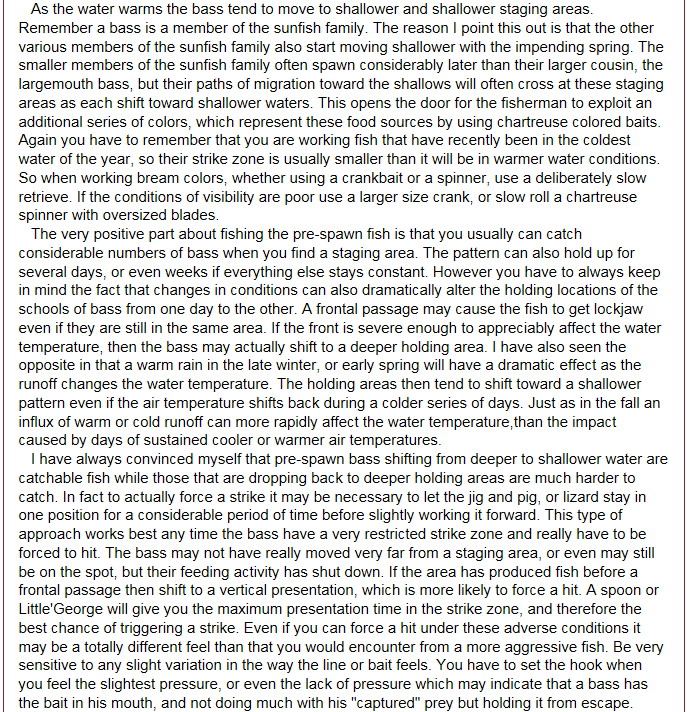


Bass Spawning




Seasonal Habits of the Largemouth Bass
Prespawn
Early spring is one of the easiest times to catch largemouth bass. They will start to move up from deep water when the water temperature starts climbing above the 45 degree mark. Keep an eye on the weather. Warm rain warms up a lake faster than air temperature. Generally you will find largemouths in 2 - 12 feet of water. Start fishing for bass in the early spring in the Northwest corner of the lake or reservoir, where the water temperature will be slightly warmer than elsewhere on the lake. Concentrate on outside structure off spawning flats (points, logs, humps, rocks etc.). Look for bass in shallow creek arms with wood and weed cover after a warm rain. Other bass will still be deeper, associated with river channel points.
Fish the first emerging weeds and grasses with large spinnerbaits and jigs. Slow roll a spinnerbait over structure and flip and pitch the heaviest cover you can find. A stop and go retrieve with large crankbaits and spinnerbaits can be deadly.
When the water temperature is between 55 and 65 degrees, largemouth bass will seek out a shallow, protected area for spawning.
The spawning area must have direct access to the sun's rays, so look for shallow flats protected from rough water. This spot is usually within 10 feet of shore in depth ranging from 1 to 6 feet.
The male chooses a site that is easy to defend, near a pocket of brushes, next to a sunken log or a boulder, and within easy access to deep water.
In addition, the male will not build a nest within 30 feet of another visible spawning nest. Occasionally, bass nests will be closer together, but only if they are not in a direct visual line with each other. The nests look like black or white patches (depending on bottom make up).
Generally speaking, the bigger the bass, the deeper the water and the earlier they will spawn.
Fish spinnerbaits and
soft plastic baits in reedbeds. Topwater baits work best on the
outside edges of reedbeds, secondary points, over cover and over
beds. After a
cold front
moves through, bass will not seek deeper water, they move into
heavy cover. Therefore flip the cover with jigs and worms.
If you're getting bit but not hooking up, you're probably
attracting bedding bass that are just moving the bait, but not
taking it. Use gitzits to catch bass off beds. When a bass
angles down to your bait on a bed, watch his pectoral fins. If
they're "revolving" and/or the fish turns a lighter shade of
green (i.e. brighter), he's going to bite. Use bright baits on
beds because bass don't care about the color. You need to see
the bait and the strike so use a bright color. Use a 5 inch
reaper when bluegill are spawning (usually during and just after
bass spawn).
If the beds are empty, fish points and drop-offs near flats and search for suspended bass. Post spawn bass typically are tough to catch. They spend the first two weeks after the spawn recooperating. After that, they start feeding again. Post spawn generally doesn't happen to an entire lake or at the same time due to differences in water temperature. Use a topwater bait such as a Zara Spook, even if they're 20 feet deep. Bass will also suspend under floating docks and log booms just after the spawn. Use a jerkbait, then use a jig on the second pass.
As the water
temperature climbs into the 80s or 90s, largemouths must
conserve their metabolic energy, and will move around less. Look
for them to associate strongly with cover in 1-20 feet of water,
where they can hold and ambush prey. Reservoir and lake bass
move off-shore to deeper channel ledges, points, open water
rockpiles and drop-offs, where they await schools of baitfish
and intercept them as they pass. Just how deep they go depends
on particular factors of each lake or reservoir - current,
structure, temperature, oxygen, and availability of food. The
larger fish tend to go into deeper waters, while the smaller
fish may stay in relatively shallow areas. Even in the heat of
midsummer, however, bass often return to shallow waters to feed
in the early morning, evening, and late hours. Even so, they are
rarely found in shallow waters in the middle of the day,
especially when the sun is bright and the wind is calm.
Schooling behavior begins to occur as bass feed heavily in short
bursts, then move back to their
holding stations
to conserve energy.
This is the time of year when a bass' attention is focused on
feeding. Therefore stock your tacklebox with crankbaits, jigs,
spinnerbaits, worms, spoons, topwaters and finesse lures. Search
for submerged weedlines with your
depthfinder
and concentrate on the inside edges in the morning and outside
edges in the afternoon - the more erratic the edge the better.
Look for isolated patches of weeds and fish those first. Fish
all types of weeds until a
pattern
is developed. Bass will be in an ambush mode, and won't chase
your lures. Therefore fish parallel to the structure. Use a
rattletrap over these areas in the morning, then switch to small
worms as the day progresses. Topwater baits can produce all day
long, especially on overcast days. Lily pads, algea, matted
weeds and other heavy cover are bass magnets. Fish these by
either scooting a frog, rat or spoon over the top or punch
through with a heavy jig or worm. If it's windy, focus on the
windy side of structure. Plankton is blown there which attract
the baitfish which in turn attract the bass.
Bass become more active as the water cools back into the low 70s and 60s and will attack a faster-moving bait, such as a crankbait. Fish on long, tapering points with a deep-water access; some bass will be shallow and some still deep, and a long point interfaces with both environments. Boat docks and similar shallow structures offer good fishing during the fall. River channel bars and ledges provide places for the bass to feed on baitfish. And most bass tournaments held in fall are won along channel edges in the far back ends of creeks. Search for steeper shorelines, vertical drop-offs and green weeds. Topwaters are still a good choice as are spinnerbaits, jigs and oversized crankbaits. As it gets colder, slow down your presentation and downsize your lures. Flip jigs and plastics on remaining green weeds and drag plastics on deep outside breaks.
Largemouth fishing is typically slow in the winter but it's a good time to catch a big fish. Fish in shallow lakes and concentrate on dense, shallow cover with slow-moving lures like jigs. Look for deep suspended bass on river channel drop-offs and submerged stumps. Focus on the base of deep drops and green weedlines. Fish slowly using a vertical presentation with jigs and spoons. Fish smaller baits for largemouths during cold weather than you might fish at other times. Their metabolism has slowed to the extent that they feed less often and take smaller bites when they do.
_____________________________
A Guide to Catching Crappie During the Spawn
As water temperature and daylight hours increase, crappie began their migration to shallower waters to spawn. The magic number the water temperature needs to reach is heavily debated, but most agree between 56-59 degrees will find white crappie in the process of spawning.
On many lakes, black crappie will begin the final migration when the water temperature hits 50-52 degrees, and will be done by the time the white crappie arrive. The more days of consistently warm weather bringing the water temps up, the smoother the transition will be for the crappie, and the better the fishing will be for the anglers.
How crappie spawn
Male crappie fan the nests and essentially make the bed while the females stage out from the nest. Depending on the lake and progression of the spawn, females may be farther out and much deeper than the males, or within 6 feet and at the same depth, but both sexes will be feeding aggressively up to the last stages of the female moving in and dropping her eggs. Females are then in and out rather briefly, and once they’ve dropped all of their eggs are very difficult to pinpoint and catch.
Male crappie are emphatic guards of their up and coming fry, which is why the spawn bite is the best “thump” most anglers feel all year. However it’s important to remember that the males are not actively feeding after the females have left, they are merely trying to run off any predator of the tender eggs. While the initial bite is ferocious, male crappie are only trying to kill or wound baitfish that pose a threat, and will “chomp” once or twice and then spit the bait. They are genetically geared to feed heavily prior to the spawn to prepare for the fasting that accompanies it. A quick hook-set is key, otherwise your bait will be outside of the crappie’s mouth in a matter of seconds.
The role of the female crappie during the spawn is to do one thing and one thing only: lay her eggs. Catching females with eggs pouring out of them is rare, but if it does happen you are right in the heart of the spawn, and should find aggressive males nearby. What exactly causes a female to deem it time to drop her eggs is unclear on any given body of water, but what is clear is that it usually happens in mass in particular areas, meaning if you do luck up upon one, there are more nearby in similar surroundings. Most females caught while spawn fishing are prespawn and loaded with eggs.
Where to look
Cover, cover and more cover - Before delving too far into this, a bit of clarity with regards to terminology is in order. Most crappie anglers refer to a brushpile, a stump, a stakebed, a dock or even vegetation as structure, because after all, they are all by definition “structures”. However, in the wild world of technical writing, structure refers to bottom contours like ledges, ditches, and so on, and cover encompasses anything that provides concealment to a fish.
Crappie move shallow to spawn and do so on firm bottoms, which can range from rocks to logs, but is usually performed on the lake floor surrounded by cover, which is primarily for protection against predators and mother nature’s wrath. Any shallow cover over a hard bottom is an excellent place to look for spawning crappie. Hard objects give the crappie a place to hide and protect their nest. So cover is always where you should look.
Keep track of previous spawns - Crappie are creatures of habit, and will return to spawn in the same areas that yielded success in the past given similar water levels.. It’s also important to note that an unsuccessful spawn will often result in a change of habitat during the next year’s spawn. Water levels dropping quickly during the spawn can wreak havoc on eggs, and crappie will in turn find safer areas to make beds for the next year.
Water clarity’s affect - Water clarity, or more accurately light penetration, dictates the depth crappie find comfortable at all times during the year, and especially during the spawn. Muddy to heavily stained water keeps crappie shallow, and during the spawn they can be in as little as 1 foot of water. As the water clears, crappie move deeper, and in extremely clear water can spawn as deep as 20 feet.
“Even on clear water lakes, there are feeder creeks that are murkier than the rest of the lake, and those creeks and surrounding flats are the first places to look for spawning crappie on clear water lakes,” said tournament pro and guide Kyle Schoenherr.
What’s the best bait
Get loud - Loud in crappie lures during the spawn refers to color not sound. Male crappie are generally the target when spawn fishing, and they are protecting, not feeding. They are however aggressive, and will attack anything that they deem a threat, so big, bright colors that are more visible will garner more attention and strikes. A little rattle, however, never hurts in dirty water.
Fast and slow - The predictability of crappie during the spawn is what draws so many anglers to the water. Successful spawning grounds are not secrets among fish, and when you find one angry male, there are likely many more in close proximity. Fishing fast and covering a lot of ground is key when searching for spawning fish, but once you find them, slow down and pick apart the area.
When to break out the minnows - There are times when male crappie will only “nip” at predators and baits. This often results in short strikes and missed fish, and downsizing your bait and/or tipping it with a live minnow will make the most reluctant of crappie take a bigger bite and hold on a bit longer, allowing for a proper hookset.
Which tactic to employ
Vertical jigging - When dealing with heavy cover such as brush, standing timber, and thick vegetation, vertical jigging is the best method to effectively fish an area. A long, light jig pole allows anglers to reach into, above, or around cover and drop a bait right in the crappie’s home. Active males rarely require much action from a bait, and even color can be a non-issue as long as the crappie can see the bait. A moderately slow fall and bit of up and down jigging will usually do the trick if the fish are there.
Casting to the shallows - Lakes with gravel or riprap banks will often hold spawning fish extremely shallow and without much cover. Casting a jig to the bank and dragging it back, staying just off or bouncing the bottom will trigger strikes from these fish. Utilizing a float above the jig will allow you to maintain exact control of lure depth, but an eagle-eye and lightning fast reflexes, along with a stiff 6- or 7-foot rod is necessary to make quick, strong hook-sets on fish that have no intention of eating the bait.
Spider-rigging deep cover - Although most crappie move into less than 4-foot of water to spawn, there are still some that will stay out in 6 to 8-foot of water and spawn on submerged logs or manmade cover. Logs especially are difficult to one-pole fish without a mastery of your electronics. Pushing multiple poles across logs is the most effective tactic to employ on deeper spawning crappie, but this is not a time to get every pole in the boat out. Pushing 4 to 6 poles is more than adequate, as again you will likely get many hard bites but few second chances, so reducing the number of poles will improve your odds.
Picking apart your water
Standards and “rules of thumb” are all there for a reason, they are proven advice in most situations, but every body of water is different and has its own nuances.
Small water - Ponds and creeks are shallower and warm up faster, and are ideal places to slip a small boat in or walk the edges with a long rod and pick off spawning crappie before your local lake gets hot. Finding cover on the edge of the bank is usually easy enough to do, and to increase your chances in a small boat, hang a pole or two out to the side away from the bank while vertical jigging the cover on the bank side.
If fishing from the bank and unable to find crappie in the reachable cover, clip on a small float and pitch out past the cover, or bring a spinning rod and reel and cast out to the deeper water and pull in towards the bank. Chances are, even if the crappie are not committed to the shallow cover yet, they are not far away and feeding actively.
Deep south impoundments - Down in the Lone Star State, Wally Marshall or Mr. Crappie as he’s otherwise known, looks for consistent air temps at night to let him know the spawn is on.
“On my home lakes of Lavon and Ray Roberts, once we get a couple consecutive 60 degree nights, I know it’s time to get out the jig pole and go shallow,” said Marshall. “Crappie will start moving up in the tributaries and will look for logs and sticks and any cover around a clay bottom. It’s not uncommon for us to have spawning fish in less than 2-feet of water, and I’ll be jigging any visible structure, or pitching a Joker or Crappie Thunder in black and chartreuse, white and chartreuse, or hot pink under a slip bobber up in the creeks.”
Midwest power plant lakes -“At Lake of Egypt, a power plant lake in Southern Illinois, black crappie chase the warm water throughout the winter,” Schoenherr said. “As the days grow longer in mid to late February the black crappie will start migrating towards the weedlines, and when the water reaches 50 degrees they’ll move in. Between the power plant pushing hot water out, the wind moving it around, and the tumultuous air temperature swings, the spawn is scattered throughout the lake, but once you get consistent water temps in the upper 50’s the black crappie are done, and the whites are starting the same pattern.”
Northeast river systems - Dylan Smith of D&B Ice Adventures doesn’t put his poles away after ice-out, he just trades them in for longer ones.
“My home lake is Lake Champlain, a 120-mile river system that separates Vermont from New York, and the biggest factor that determines when the spawn will begin is snowfall,” Smith said. “After ice-out the snow begins to melt and runs down into the river, and it can be as late as May before the water temperature reaches 55 degrees, which is when I’m really keying in on spawning crappie.”
Smith also uses other sources to pinpoint when crappie move shallow.
“When the osprey are diving in the shallows this time of year, it’s usually after spawning crappie,” said Smith. “I’m looking for beds in as deep as 12-feet of water with my side imaging to cast and retrieve through, or cover in as shallow as 1-foot of water to vertical jig, and am using anything from marabou jigs to Lake Fork Live Baby Shad plastics.”
Crappie fishing the spawn gives anglers the best chance at loading the boat with concentrated numbers of tenacious slabs from ultra shallow water. Paying attention to water conditions and recalling recent spawns, along with staying on the move to find actively spawning crappie can result in multiple successful trips catching America’s favorite panfish.